高一牛津/school life[下学期]
文档属性
| 名称 | 高一牛津/school life[下学期] | 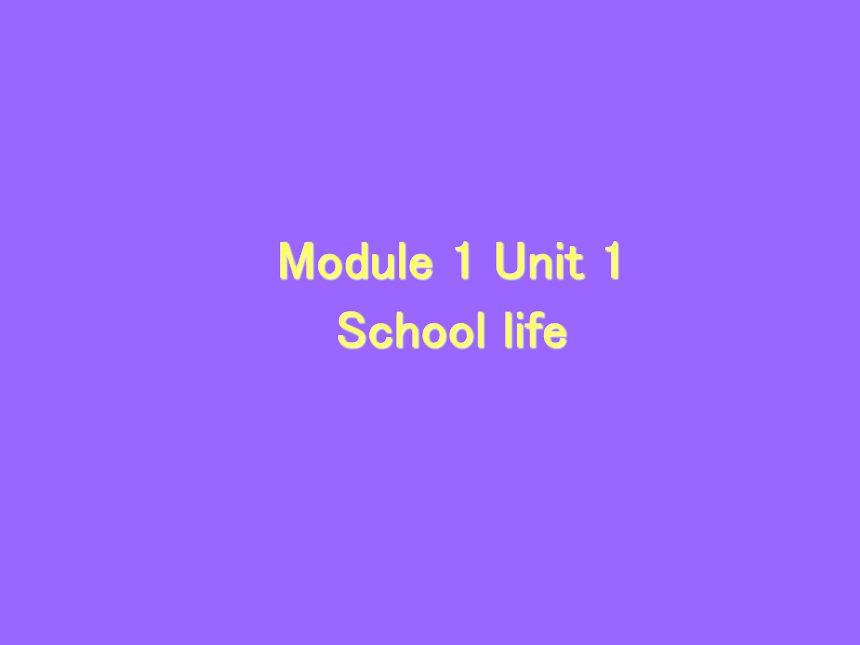 | |
| 格式 | rar | ||
| 文件大小 | 6.4MB | ||
| 资源类型 | 教案 | ||
| 版本资源 | 牛津译林版 | ||
| 科目 | 英语 | ||
| 更新时间 | 2006-02-22 20:41:00 | ||
图片预览

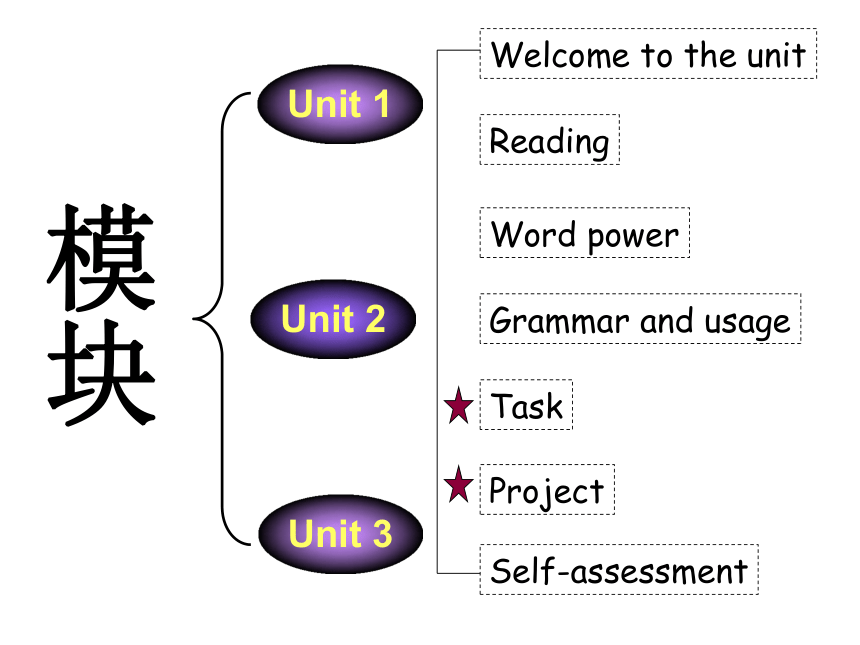
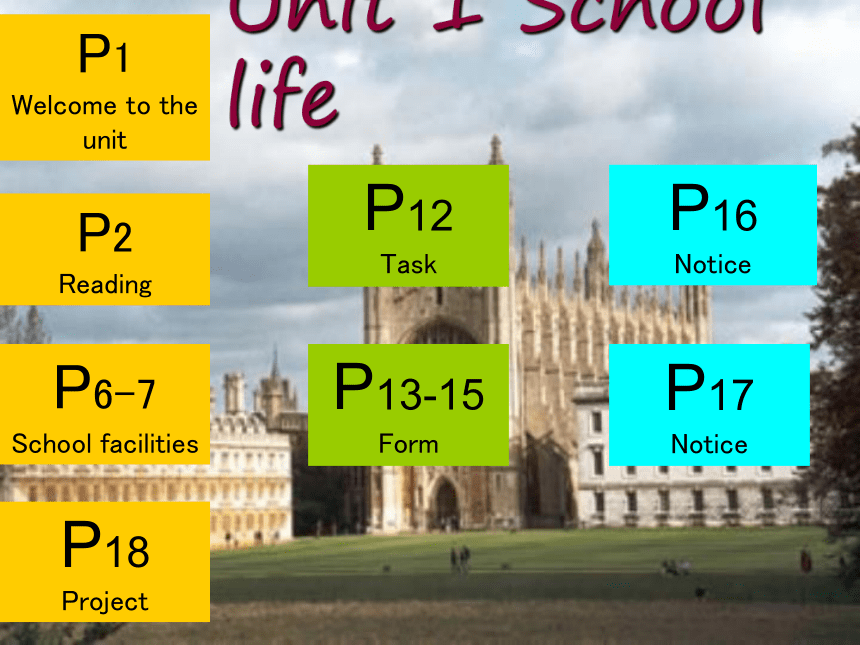
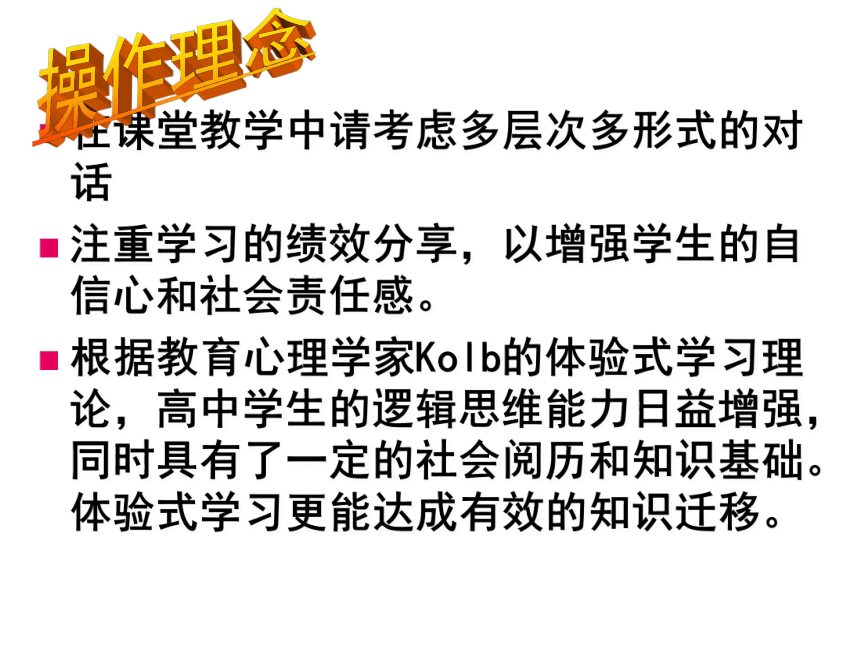
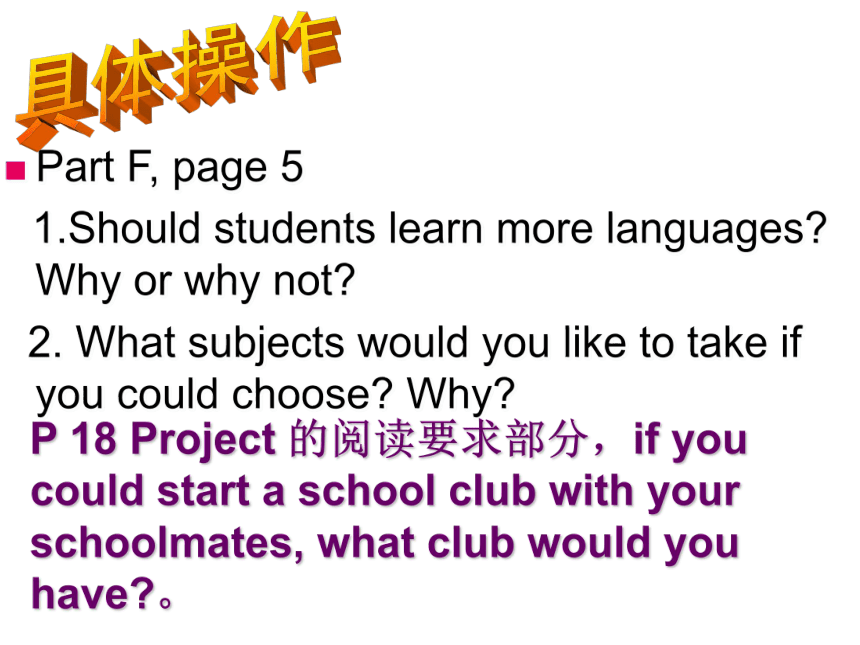
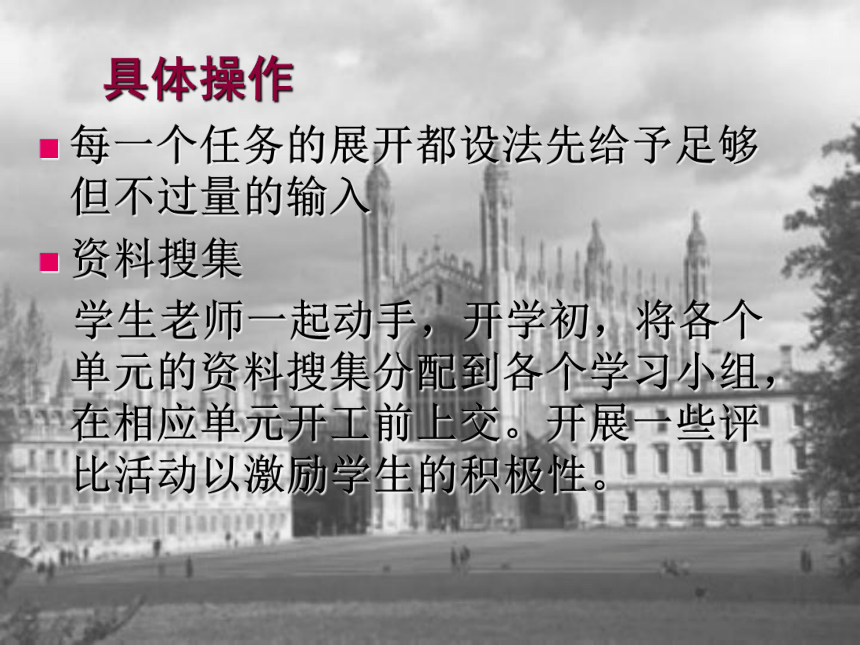
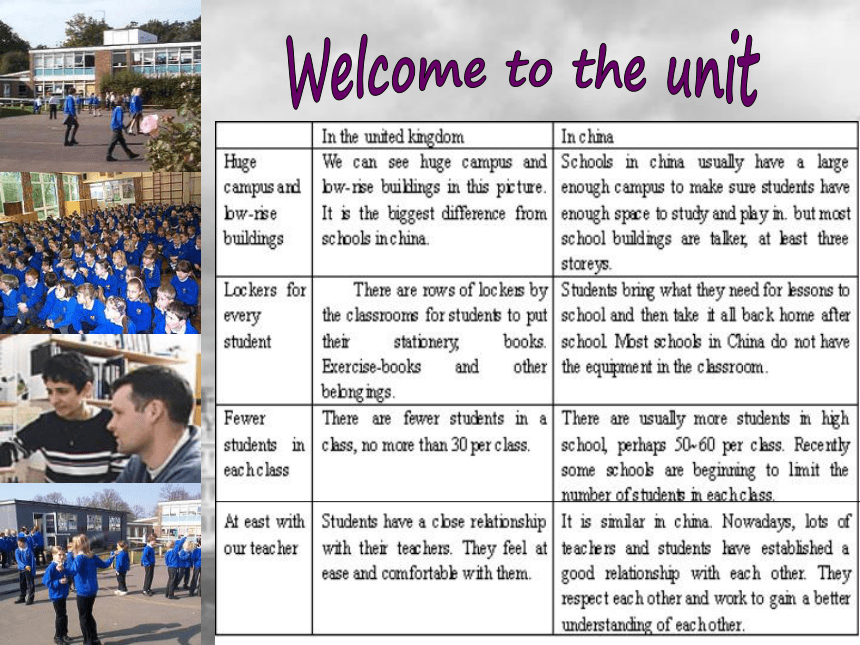
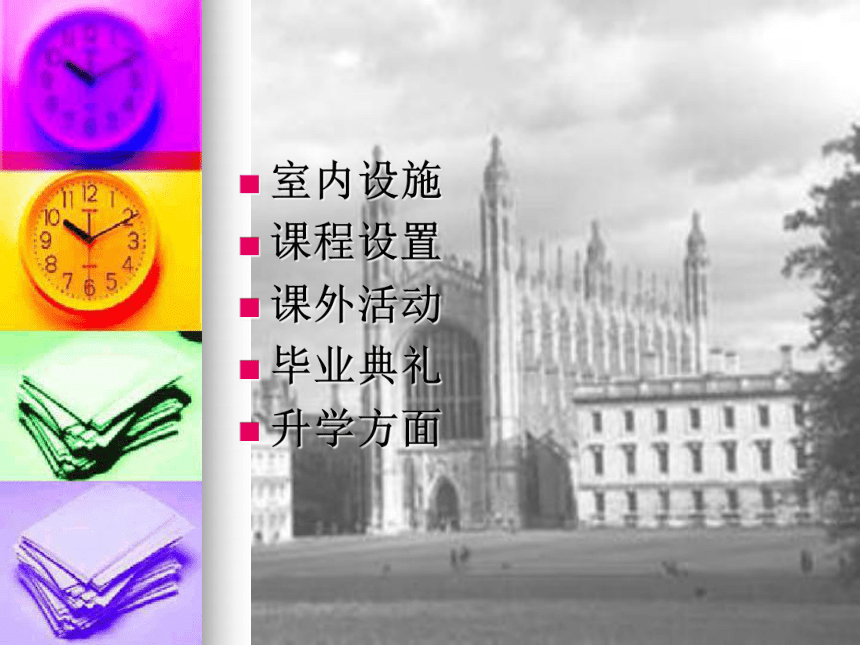
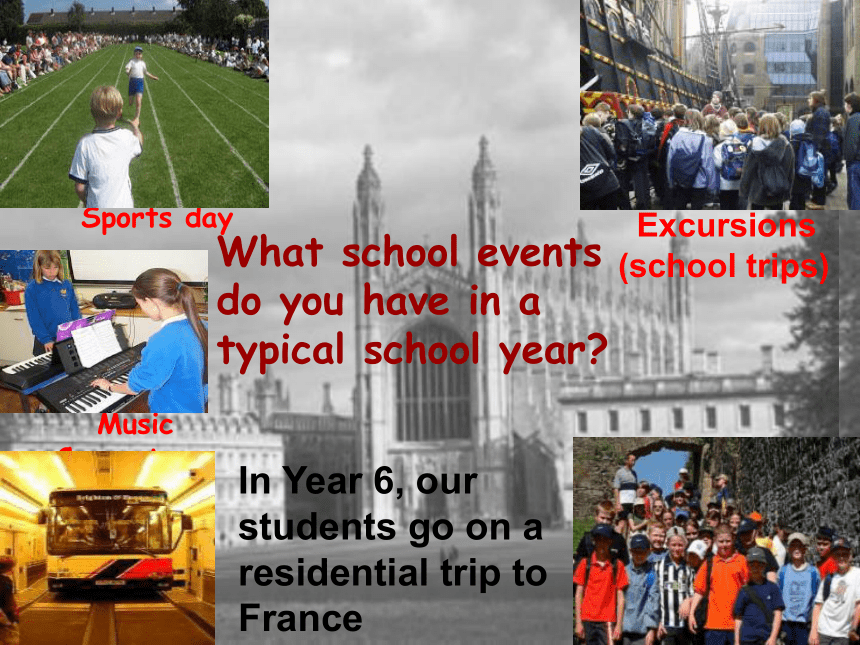
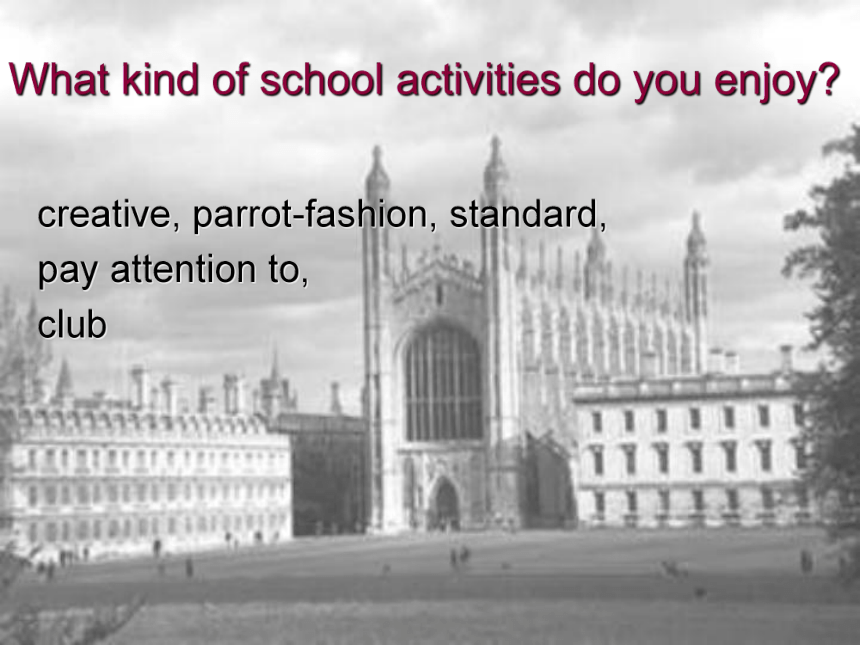
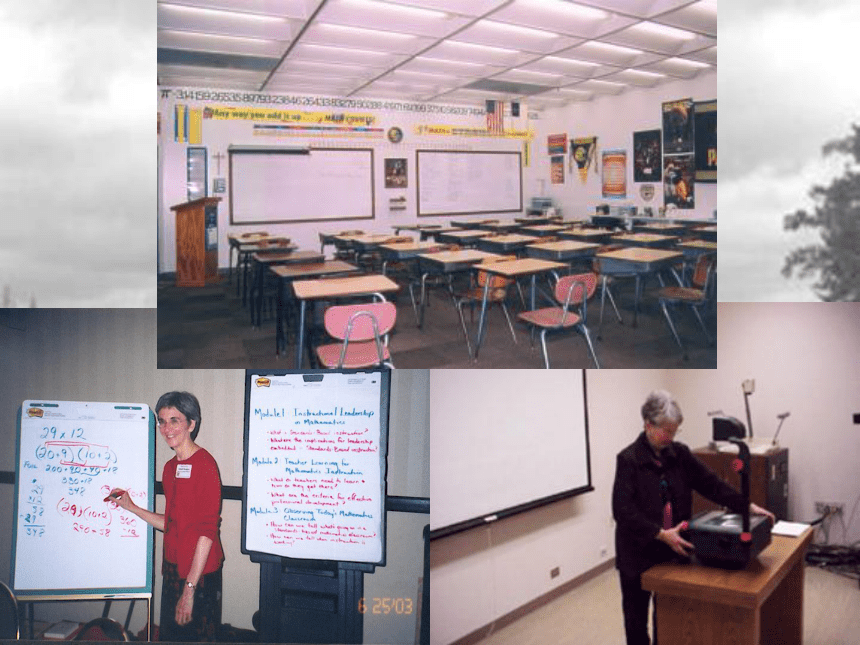

文档简介
课件52张PPT。Module 1 Unit 1
School life 模块Unit 1Unit 2Unit 3Welcome to the unitReadingWord powerGrammar and usageTaskProjectSelf-assessmentUnit 1 School lifeP17
NoticeP1
Welcome to the unitP2
ReadingP6-7
School facilitiesP18
ProjectP12
TaskP13-15
FormP16
Notice在课堂教学中请考虑多层次多形式的对话
注重学习的绩效分享,以增强学生的自信心和社会责任感。
根据教育心理学家Kolb的体验式学习理论,高中学生的逻辑思维能力日益增强,同时具有了一定的社会阅历和知识基础。体验式学习更能达成有效的知识迁移。操作理念Part F, page 5
1.Should students learn more languages? Why or why not?
2. What subjects would you like to take if you could choose? Why?
P 18 Project 的阅读要求部分,if you could start a school club with your schoolmates, what club would you have?。具体操作具体操作每一个任务的展开都设法先给予足够但不过量的输入
资料搜集
学生老师一起动手,开学初,将各个单元的资料搜集分配到各个学习小组,在相应单元开工前上交。开展一些评比活动以激励学生的积极性。Welcome to the unit室内设施
课程设置
课外活动
毕业典礼
升学方面 What school events do you have in a typical school year?
?????????????
??????????Sports day ? ??????????????????????Music Concert In Year 6, our students go on a residential trip to France??Excursions (school trips) What kind of school activities do you enjoy?creative, parrot-fashion, standard,
pay attention to,
club 这里为大家提供一个网站,希望对备课有所帮助:
http://www.saffronwalden.essex.sch.uk
http://www.woodlands-junior.kent.sch.uk/schday/regisassem.html
Reading(P2~P5)Reading(P2)
P9
Project(P18) 主阅读副阅读课文教学阅读教学Part A
Part B
Part C1
Part C2
Part D
Part E
Part FPre-readingReading(P2~P5)Reading strategy Learn how to learnLead-in从情境入手Reading Comprehension预测内容利用本文可突出学生3个方面的能力:
A:文章中心把握能力:设及高考题中作者意图推测,标题选择,段落大意确定。
B:信息归类:
Eg. The similarity and difference in the school life
C: 生词猜测。Attend, drop, earn etc.Part AHow long did Wei Hua stay in Britain?
What was the name of Wei Hua’s class teacher?
What did Wei Hua main in her woodwork class?What happened on her first school day?
(To attend assembly)
How did she like the homework at first?
(A bit challenging)
etc.
attend assemblyPart C1-C2C1的问题是考查学生定位具体信息的能力;
C2旨在帮助学生加深对文章的理解。 Self-evaluate 1)(optional)Self-evaluate 2)(optional)Are the following aspects of school life mentioned in the article?
Teachers. Classmates. Friends. Subjects, homework/assignments. Grades. Timetable, activities, school facilities, host family, food, hobbies. Customs. Traditions. festivalsPart B 整体性阅读 随意性提问,发散学生思维
教师在讲解语篇的过程中,要挖掘一些不是问题的问
题,就象投石击水,让学生的思维荡起涟漪,这样,既
可以让学生在听讲疲劳时,大脑兴奋起来,做到课堂教
学的动静交替;又可让学生在集体中相互补充,增强他
们的语言表达能力。
E.g.
Is it good to move to different classrooms for different classes?Ex D & EComplete D and E individually.
The meanings of the words in D are not difficult for them to identify after students have read through the passage twice.
E is a letter. It requires students to understand the letter first and then write down the missing words to make it meaningful.Self-evaluate 3)(optional)别忘了课后练习部分!Workbook P82-83
Article A
What does the phrase school uniforms mean?
What kinds of clothes are fashionable?
What clothes are leisure clothes?别忘了课后练习部分!Article B
1. When you are taking SATS, you will______________.
A. have to find answers to some math questions only
B. only solve some problems
C. be chosen by the best colleges
D. be tested on some math questions as well as some problem-solving questionsArticle B2. A special counselor is a person ______.
A. who wants to go to a very good college
B. who works in a high school to help students choose suitable colleges to go to
C. who works in a college or a university to help high school students choose suitable colleges to go to
D. who writes letter of application to colleges for high school students整个单元练习的设计由简到繁,由易到难,层层深入。
Reading (II)1.难句:
1.Going to a British high school for one year has been a very enjoyable and exciting experience for me.(Page 2, Line 1)
2. He also told us that the best way to earn respect form the school was to work hard and achieve high grades. (Page 2, Line 9)
3. … It was difficult to remember all the faces and names.(Page 2, Line 18)
4.I found the homework was not as heavy as what I used to get in my old school…(Page 2 , Line 20)
5. I usually went to the Computer Club at lunchtime, so I could e-mail my family and friends back home for free.(Page 3, Line 28)
6. Though it didn’t look like a table when it was finished, I still liked it very much.(Page3, Line 40)词汇教学 word formation1. enjoy v. 欣赏,喜爱 enjoyable: adj. 令人愉快的, 可享受的
2. achieve v. 获得 achievement n. 成就,功绩
3. prepare. v. 准备 preparation n. 准备,预备
4. experience v. 体验 experience. [C] 经历
experienced. adj. 富有经验的 [U]经验
5.help v 帮助 help n. 帮助
helpful adj. 有帮助的
6. introduce v. 介绍 introduction n. 介绍
7. develop v. 发展 development n. 发展 developed adj. 发达的 developing adj. 发展中的
8. donate v . 捐赠,赠予 donation n.捐赠品,捐款
9. display v . 陈列,展览 display n. 陈列,展览
10. please v 使。。。喜欢 pleasure n. 愉快;乐事
pleased adj. 高兴的,满足的 pleasing adj. 令人高兴的词汇表上的所谓生词相当有限,文章里、练习中还有一部分生词并未列出。
旧+新
分段讲解,各个击破
熟词新义
drop miss etc
词汇教学artroomgymWord powercanteendormitorylecture hallcar parkDiscuss1. Do you think having a gym is an important factor for students when choosing a school?
Why are more and more key schools spending a large amount of money in improving their school facilities?
Do you think it is necessary for all schools to have this kind of equipment?Watch a videoGrammar 1.学生在初中时接触过定语从句,但只是皮毛。学生了解的是,当先行词是人时,关系代词用什么,先行词是物时, 关系代词又用什么,当表示所有格时,需什么引导,对关系代词可省的情况没有接触,需要教师补上这一课。
可以先出几道简单的练习测验学生,或是给出一个今定语从句的例句,和学生复习关系代词、先行词等概念。
2。在学生掌握情况比较好的情况下,完成第9面的任务—划出文章里的定语从句。文章长,生词不少,对于普通中学学生而言,有一定的难度,可以由教师划出句子,让学生说出主语,先行词,定语从句部分。
3。在这篇文章里有一句话是个难点---Upon finishing his studies, he started traveling in China(Para 2).需要教师稍加说明upon的用法。TaskSkills building 1 understanding a programme
Skills building 2:
comparing information
Skills building 3:
writing a noticeStep 1
Step 2
Step 3讨论
要求
听力练习
Project教材分析:这是牛津教材有别于以往教材的一个设计,目的在于通过学生合作式学习利用所学内容完成一个项目。个人成长除了个人奋斗,学会与人合作同样重要,这也是教师在教学中所要渗透的一种理念,是教育界把知识教育(knowledge education)转变为能力教育(capacity education)或方法教育(methodology education)的体现,是把教育变为教人做事和做人的过程,也是把教师为中心转变为学生为中心的教学过程。1.教师可设计以下表格帮助学生理解两段材料(以第一篇为例)2。P79面B1,方框里的词组可以帮助学生理解材料。
3。设计海报 Improvement Common
Specialties Vocabulary下面为大家列出一些练习中没有出现的单词,希望在讲解时以及自己出练习时能加以训练:
Earn, respect, achieve, miss challenging, cooking, prepare,, experience, introduce, develop, donate, display, pay attention to, regret, run, approve, broadcast, continue.课时分布 1.Welcome+ Reading 3.5
2. Word power 1.5
3.Grammar 2
4. Task 1.5
5. Project 2~2.5
共计:10~11每个单元的“Welcome to the unit”这个版块,学生们都能接触到符合他们年龄和认知特点的话题。建议:教师在处理这个版块时,最好能课前布置学生搜索和话题有关 的资料,鼓励他们不只是简单的摘录相关信息,要学会自己重组信息。在此过程中,教师起先的引导示范尤为关键,提醒学生若他们所收集的资料中含有大量的词汇,应学会摒弃,而绝不能照搬照抄或不断的借助于电子词典来勉强读完。教师在备课时,也应准备一些有趣的、简单易懂的相关信息,不仅可以增加学生学习的兴趣,提高他们的学习积极性和课堂参与性,而且大量的课堂输入使学生在潜移默化中增加了知识面。教师可以逐个处理每幅图片,或找出图片的共同特征,设计相关问题激发学生的参与热情。在此过程中,学生的小组讨论可以穿插进行。在整个的教学过程中,教师和学生的互动交流必须一直贯穿始终。)建议教师在处理文章时,不妨先从标题和图片入手,设计相关活动和问题,让学生展开联想,预测下文。
教师在处理阅读的步骤和程序时,尽量做到不拘于形式,尽可能的结合所教文章的题材和体裁,灵活处理课文后的练习。每个单元的练习A是用来检测学生略读完后的理解大意情况;练习C1和C2均围绕课文的重点细节所设计,形式包括回答问题、选择题、图表、排序等,培养学生学会获取信息和处理信息的能力。所有单元有关词汇的练习C都是安排在学生阅读完两遍后进行的。其目的是培养学生根据上下文的语境猜词悟义,在阅读 过程中理解词汇。练习E则是运用语篇形式,采用缺词填空的方式检测学生的阅读情况,是对词汇和阅读的巩固。整个单元练习的设计由简到繁,由易到难,层层深入。此外,教参中对每个单元的阅读都提供了补充练习,便于教师检测学生或学生自我检测其对于所学课文的综合理解。 教师可以在阅读完成后,让学生先自己归纳总结技巧,然后引导学生进行学习;或在学生阅读过程中,适当穿插点拨,最后学习;或在阅读开始前通过与学生提问互动的方式,先教会阅读技巧。总之,教师可以根据课型和学生的水平灵活处理。若可能的前提下,教师在备课时,可以查找和挑选适当的短文,让学生在掌握好Reading strategy的基础上,做个自我反馈和检测的练习 教学计划及安排两多: 多元化 multicultural
多媒体 multimedia
两贴近:贴近学生生活
(relevant to student’s lives)
贴近职业市场
(career-oriented) http://www.yilin.com/cn/edu/Senior_high_oxford_training_materials.asp
牛津高中英语培训材料
参考网站:
School life 模块Unit 1Unit 2Unit 3Welcome to the unitReadingWord powerGrammar and usageTaskProjectSelf-assessmentUnit 1 School lifeP17
NoticeP1
Welcome to the unitP2
ReadingP6-7
School facilitiesP18
ProjectP12
TaskP13-15
FormP16
Notice在课堂教学中请考虑多层次多形式的对话
注重学习的绩效分享,以增强学生的自信心和社会责任感。
根据教育心理学家Kolb的体验式学习理论,高中学生的逻辑思维能力日益增强,同时具有了一定的社会阅历和知识基础。体验式学习更能达成有效的知识迁移。操作理念Part F, page 5
1.Should students learn more languages? Why or why not?
2. What subjects would you like to take if you could choose? Why?
P 18 Project 的阅读要求部分,if you could start a school club with your schoolmates, what club would you have?。具体操作具体操作每一个任务的展开都设法先给予足够但不过量的输入
资料搜集
学生老师一起动手,开学初,将各个单元的资料搜集分配到各个学习小组,在相应单元开工前上交。开展一些评比活动以激励学生的积极性。Welcome to the unit室内设施
课程设置
课外活动
毕业典礼
升学方面 What school events do you have in a typical school year?
?????????????
??????????Sports day ? ??????????????????????Music Concert In Year 6, our students go on a residential trip to France??Excursions (school trips) What kind of school activities do you enjoy?creative, parrot-fashion, standard,
pay attention to,
club 这里为大家提供一个网站,希望对备课有所帮助:
http://www.saffronwalden.essex.sch.uk
http://www.woodlands-junior.kent.sch.uk/schday/regisassem.html
Reading(P2~P5)Reading(P2)
P9
Project(P18) 主阅读副阅读课文教学阅读教学Part A
Part B
Part C1
Part C2
Part D
Part E
Part FPre-readingReading(P2~P5)Reading strategy Learn how to learnLead-in从情境入手Reading Comprehension预测内容利用本文可突出学生3个方面的能力:
A:文章中心把握能力:设及高考题中作者意图推测,标题选择,段落大意确定。
B:信息归类:
Eg. The similarity and difference in the school life
C: 生词猜测。Attend, drop, earn etc.Part AHow long did Wei Hua stay in Britain?
What was the name of Wei Hua’s class teacher?
What did Wei Hua main in her woodwork class?What happened on her first school day?
(To attend assembly)
How did she like the homework at first?
(A bit challenging)
etc.
attend assemblyPart C1-C2C1的问题是考查学生定位具体信息的能力;
C2旨在帮助学生加深对文章的理解。 Self-evaluate 1)(optional)Self-evaluate 2)(optional)Are the following aspects of school life mentioned in the article?
Teachers. Classmates. Friends. Subjects, homework/assignments. Grades. Timetable, activities, school facilities, host family, food, hobbies. Customs. Traditions. festivalsPart B 整体性阅读 随意性提问,发散学生思维
教师在讲解语篇的过程中,要挖掘一些不是问题的问
题,就象投石击水,让学生的思维荡起涟漪,这样,既
可以让学生在听讲疲劳时,大脑兴奋起来,做到课堂教
学的动静交替;又可让学生在集体中相互补充,增强他
们的语言表达能力。
E.g.
Is it good to move to different classrooms for different classes?Ex D & EComplete D and E individually.
The meanings of the words in D are not difficult for them to identify after students have read through the passage twice.
E is a letter. It requires students to understand the letter first and then write down the missing words to make it meaningful.Self-evaluate 3)(optional)别忘了课后练习部分!Workbook P82-83
Article A
What does the phrase school uniforms mean?
What kinds of clothes are fashionable?
What clothes are leisure clothes?别忘了课后练习部分!Article B
1. When you are taking SATS, you will______________.
A. have to find answers to some math questions only
B. only solve some problems
C. be chosen by the best colleges
D. be tested on some math questions as well as some problem-solving questionsArticle B2. A special counselor is a person ______.
A. who wants to go to a very good college
B. who works in a high school to help students choose suitable colleges to go to
C. who works in a college or a university to help high school students choose suitable colleges to go to
D. who writes letter of application to colleges for high school students整个单元练习的设计由简到繁,由易到难,层层深入。
Reading (II)1.难句:
1.Going to a British high school for one year has been a very enjoyable and exciting experience for me.(Page 2, Line 1)
2. He also told us that the best way to earn respect form the school was to work hard and achieve high grades. (Page 2, Line 9)
3. … It was difficult to remember all the faces and names.(Page 2, Line 18)
4.I found the homework was not as heavy as what I used to get in my old school…(Page 2 , Line 20)
5. I usually went to the Computer Club at lunchtime, so I could e-mail my family and friends back home for free.(Page 3, Line 28)
6. Though it didn’t look like a table when it was finished, I still liked it very much.(Page3, Line 40)词汇教学 word formation1. enjoy v. 欣赏,喜爱 enjoyable: adj. 令人愉快的, 可享受的
2. achieve v. 获得 achievement n. 成就,功绩
3. prepare. v. 准备 preparation n. 准备,预备
4. experience v. 体验 experience. [C] 经历
experienced. adj. 富有经验的 [U]经验
5.help v 帮助 help n. 帮助
helpful adj. 有帮助的
6. introduce v. 介绍 introduction n. 介绍
7. develop v. 发展 development n. 发展 developed adj. 发达的 developing adj. 发展中的
8. donate v . 捐赠,赠予 donation n.捐赠品,捐款
9. display v . 陈列,展览 display n. 陈列,展览
10. please v 使。。。喜欢 pleasure n. 愉快;乐事
pleased adj. 高兴的,满足的 pleasing adj. 令人高兴的词汇表上的所谓生词相当有限,文章里、练习中还有一部分生词并未列出。
旧+新
分段讲解,各个击破
熟词新义
drop miss etc
词汇教学artroomgymWord powercanteendormitorylecture hallcar parkDiscuss1. Do you think having a gym is an important factor for students when choosing a school?
Why are more and more key schools spending a large amount of money in improving their school facilities?
Do you think it is necessary for all schools to have this kind of equipment?Watch a videoGrammar 1.学生在初中时接触过定语从句,但只是皮毛。学生了解的是,当先行词是人时,关系代词用什么,先行词是物时, 关系代词又用什么,当表示所有格时,需什么引导,对关系代词可省的情况没有接触,需要教师补上这一课。
可以先出几道简单的练习测验学生,或是给出一个今定语从句的例句,和学生复习关系代词、先行词等概念。
2。在学生掌握情况比较好的情况下,完成第9面的任务—划出文章里的定语从句。文章长,生词不少,对于普通中学学生而言,有一定的难度,可以由教师划出句子,让学生说出主语,先行词,定语从句部分。
3。在这篇文章里有一句话是个难点---Upon finishing his studies, he started traveling in China(Para 2).需要教师稍加说明upon的用法。TaskSkills building 1 understanding a programme
Skills building 2:
comparing information
Skills building 3:
writing a noticeStep 1
Step 2
Step 3讨论
要求
听力练习
Project教材分析:这是牛津教材有别于以往教材的一个设计,目的在于通过学生合作式学习利用所学内容完成一个项目。个人成长除了个人奋斗,学会与人合作同样重要,这也是教师在教学中所要渗透的一种理念,是教育界把知识教育(knowledge education)转变为能力教育(capacity education)或方法教育(methodology education)的体现,是把教育变为教人做事和做人的过程,也是把教师为中心转变为学生为中心的教学过程。1.教师可设计以下表格帮助学生理解两段材料(以第一篇为例)2。P79面B1,方框里的词组可以帮助学生理解材料。
3。设计海报 Improvement Common
Specialties Vocabulary下面为大家列出一些练习中没有出现的单词,希望在讲解时以及自己出练习时能加以训练:
Earn, respect, achieve, miss challenging, cooking, prepare,, experience, introduce, develop, donate, display, pay attention to, regret, run, approve, broadcast, continue.课时分布 1.Welcome+ Reading 3.5
2. Word power 1.5
3.Grammar 2
4. Task 1.5
5. Project 2~2.5
共计:10~11每个单元的“Welcome to the unit”这个版块,学生们都能接触到符合他们年龄和认知特点的话题。建议:教师在处理这个版块时,最好能课前布置学生搜索和话题有关 的资料,鼓励他们不只是简单的摘录相关信息,要学会自己重组信息。在此过程中,教师起先的引导示范尤为关键,提醒学生若他们所收集的资料中含有大量的词汇,应学会摒弃,而绝不能照搬照抄或不断的借助于电子词典来勉强读完。教师在备课时,也应准备一些有趣的、简单易懂的相关信息,不仅可以增加学生学习的兴趣,提高他们的学习积极性和课堂参与性,而且大量的课堂输入使学生在潜移默化中增加了知识面。教师可以逐个处理每幅图片,或找出图片的共同特征,设计相关问题激发学生的参与热情。在此过程中,学生的小组讨论可以穿插进行。在整个的教学过程中,教师和学生的互动交流必须一直贯穿始终。)建议教师在处理文章时,不妨先从标题和图片入手,设计相关活动和问题,让学生展开联想,预测下文。
教师在处理阅读的步骤和程序时,尽量做到不拘于形式,尽可能的结合所教文章的题材和体裁,灵活处理课文后的练习。每个单元的练习A是用来检测学生略读完后的理解大意情况;练习C1和C2均围绕课文的重点细节所设计,形式包括回答问题、选择题、图表、排序等,培养学生学会获取信息和处理信息的能力。所有单元有关词汇的练习C都是安排在学生阅读完两遍后进行的。其目的是培养学生根据上下文的语境猜词悟义,在阅读 过程中理解词汇。练习E则是运用语篇形式,采用缺词填空的方式检测学生的阅读情况,是对词汇和阅读的巩固。整个单元练习的设计由简到繁,由易到难,层层深入。此外,教参中对每个单元的阅读都提供了补充练习,便于教师检测学生或学生自我检测其对于所学课文的综合理解。 教师可以在阅读完成后,让学生先自己归纳总结技巧,然后引导学生进行学习;或在学生阅读过程中,适当穿插点拨,最后学习;或在阅读开始前通过与学生提问互动的方式,先教会阅读技巧。总之,教师可以根据课型和学生的水平灵活处理。若可能的前提下,教师在备课时,可以查找和挑选适当的短文,让学生在掌握好Reading strategy的基础上,做个自我反馈和检测的练习 教学计划及安排两多: 多元化 multicultural
多媒体 multimedia
两贴近:贴近学生生活
(relevant to student’s lives)
贴近职业市场
(career-oriented) http://www.yilin.com/cn/edu/Senior_high_oxford_training_materials.asp
牛津高中英语培训材料
参考网站:
